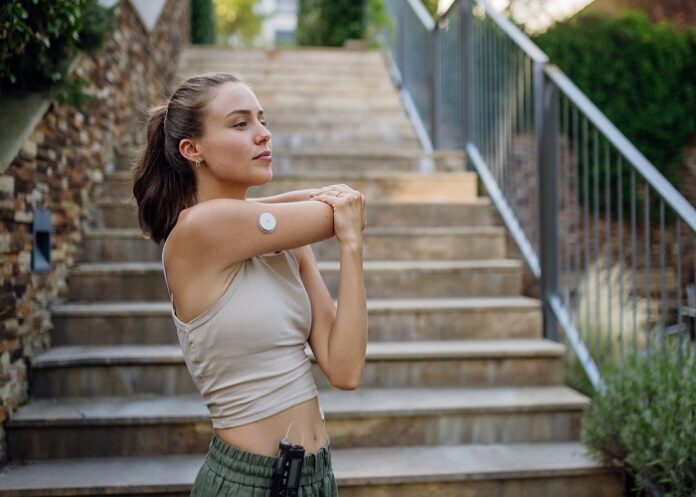The tiny continuous glucose monitors used by diabetics to track their blood glucose levels have become popular among athletes who hope to boost their medal chances in the Paris Olympics, reports Reuters. Health care giants Abbott and Dexcom are now seeing opportunities in sports and wellness, despite the lack so far of validated science.
Continuous glucose monitors or CGMs – which attach to the skin to monitor glucose levels – were initially developed specifically for diabetes patients.
“I foresee a day where CGM will certainly be used outside diabetes in a big way,” said Dexcom’s Chief Operating Officer Jacob Leach, adding that although diabetes patients remain the company’s commercial focus, it was also working with researchers on future use to optimise athletic performance. He would not disclose details.
The CGM market is already worth billions of dollars, thanks to demand from diabetes patients, who use the coin-sized adhesive skin patches with a Bluetooth link to a smartphone instead of drawing blood through a finger stick. The readings help determine whether they need an insulin dose.
In March, Dexcom’s Stelo device, targeting people with early-stage diabetes who are not on insulin, became the first CGM to win US approval for purchase without a prescription. Launch is planned for later this year.
Abbott had introduced a CGM product for amateur and elite sports users without diabetes in Europe as early as 2020 and has sponsored Kenyan marathon great Eliud Kipchoge and his team since 2021.
A number of top athletes and their support staff have been using CGMs to optimise calorie intake and workout intensity in preparation for sport events.
Abbott said it is targeting the non-diabetic consumer market, and last week, won US approval for its prescription-free Lingo device and smartphone app for health and well-being, available in Britain since January.
Also last week, Abbott won US clearance for its non-prescription system Libre Rio, for diabetics who do not need insulin, to compete with arch-rival Dexcom’s Stelo.
CGM guides training
Dutch marathoner Abdi Nageeye said he and his coaches are monitoring blood glucose as an indicator of the body’s available energy, and that CGM use has guided him to work on sleeping and eating patterns so that he expends a minimum of energy during training.
While companies see growth potential in the gadgets, sports nutrition scientists see a promising field of research.
“A big guesswork for endurance athletes has always been: am I training hard enough or am I training too hard? It seems with CGMs, we have a better understanding,” said Associate Professor Filip Larsen of the Swedish School of Sport and Health Sciences.
He warned, however, that there was little validated science yet on how to optimise an athlete’s routines using CGMs.
“Most researchers cannot give you the exact answers. In five years, we will know ten times as much as we do now.”
Sports dietician Greg Cox, associate professor at Australia’s Bond University, has worked with swimmers and rowers, triathletes and track athletes.
He said results of a trial run by his team to test how not eating enough calories to sustain the intensity of exercise would affect endurance athletes’ glucose readings have so far been inconclusive, that more research into CGMs was needed.
Both Cox and Larsen expressed scepticism about non-diabetic consumers using the technology for health and fitness without professional advice.
“What I see on social media is that normal, healthy people get scared when they have one banana and their blood glucose goes up really high for one hour. This is completely expected and a normal response,” said Larsen.
Market leader Abbott told Reuters that understanding blood-glucose swings is key to managing one’s metabolism for a healthier life.
“While glucose spikes are normal in healthy people, we also know that having fewer frequent and large spikes and crashes in glucose is associated with improved energy, mood, focus, sleep, and reduces cravings,” a spokesperson said.
Study details
The Use of Continuous Glucose Monitors in Sport: Possible Applications and Considerations
Amy-Lee Bowler, Jamie Whitfield, Lachlan Marshall, Vernon Coffey, et al.
Published in the International Journal of Sport Nutrition & Exercise Metabolism in December 2022
Abstract
This review discusses the potential value of tracking interstitial glucose with continuous glucose monitors (CGMs) in athletes, highlighting possible applications and important considerations in the collection and interpretation of interstitial glucose data. CGMs are sensors that provide real time, longitudinal tracking of interstitial glucose with a range of commercial monitors currently available. Recent advancements in CGM technology have led to the development of athlete-specific devices targeting glucose monitoring in sport. Although largely untested, the capacity of CGMs to capture the duration, magnitude, and frequency of interstitial glucose fluctuations every 1–15 min may present a unique opportunity to monitor fuelling adequacy around competitive events and training sessions, with applications for applied research and sports nutrition practice. Indeed, manufacturers of athlete-specific devices market these products as a “fuelling gauge,” enabling athletes to “push their limits longer and get bigger gains.” However, as glucose homeostasis is a complex phenomenon, extensive research is required to ascertain whether systemic glucose availability (estimated by CGM-derived interstitial glucose) has any meaning in relation to the intended purposes in sport. Whether CGMs will provide reliable and accurate information and enhance sports nutrition knowledge and practice is currently untested. Caveats around the use of CGMs include technical issues (dislodging of sensors during periods of surveillance, loss of data due to synchronisation issues), practical issues (potential bans on their use in some sporting scenarios, expense), and challenges to the underpinning principles of data interpretation, which highlight the role of sports nutrition professionals to provide context and interpretation.
Reuters article – Olympic athletes turn to diabetes tech in pursuit of medals
See more from MedicalBrief archives:
Wearable sensor provides minimally invasive glucose monitoring
Continuous glucose monitoring improves glycaemic control versus finger-prick
‘Wristwatch’ monitors body chemistry to boost athletic performance, prevent injury
Non-invasive, adhesive patch measures glucose levels through skin

